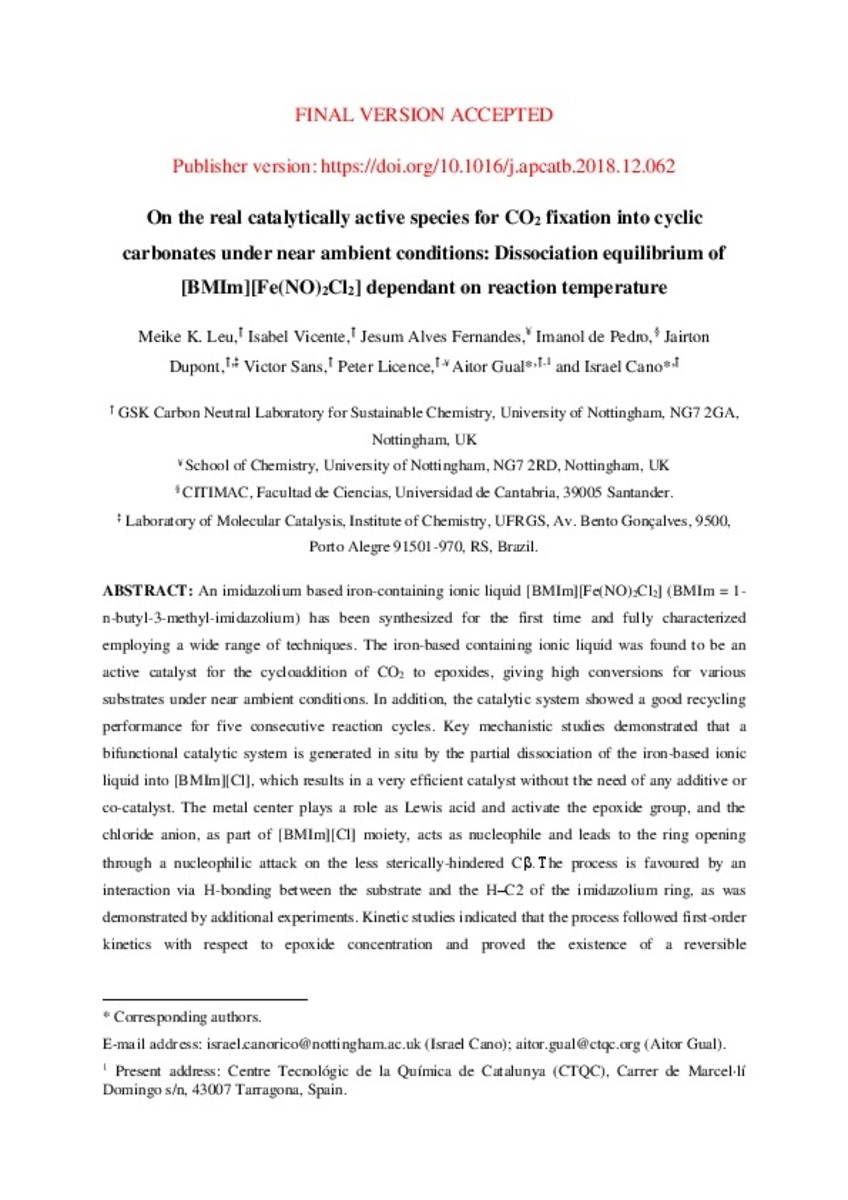| dc.contributor.author | Leu, Meike K. | |
| dc.contributor.author | Vicente, Isabel | |
| dc.contributor.author | Alves Fernandes, Jesum | |
| dc.contributor.author | de Pedro, manuel | |
| dc.contributor.author | Dupont, Jairton | |
| dc.contributor.author | Sans, Victor | |
| dc.contributor.author | Licence, Peter | |
| dc.contributor.author | Gual, Aitor | |
| dc.contributor.author | Cano, Israel | |
| dc.date.accessioned | 2019-12-13T08:41:04Z | |
| dc.date.available | 2019-12-13T08:41:04Z | |
| dc.date.issued | 2019-05-15 | |
| dc.identifier.citation | LEU, Meike K., et al. On the real catalytically active species for CO2 fixation into cyclic carbonates under near ambient conditions: Dissociation equilibrium of [BMIm][Fe (NO) 2Cl2] dependant on reaction temperature. Applied Catalysis B: Environmental, 2019, vol. 245, p. 240-250 | ca_CA |
| dc.identifier.issn | 0926-3373 | |
| dc.identifier.uri | http://hdl.handle.net/10234/185442 | |
| dc.description.abstract | An imidazolium based iron-containing ionic liquid [BMIm][Fe(NO)2Cl2] (BMIm = 1-n-butyl-3-methyl-imidazolium) has been synthesized for the first time and fully characterized employing a wide range of techniques. The iron-based containing ionic liquid was found to be an active catalyst for the cycloaddition of CO2 to epoxides, giving high conversions for various substrates under near ambient conditions. In addition, the catalytic system showed a good recycling performance for five consecutive reaction cycles. Key mechanistic studies demonstrated that a bifunctional catalytic system is generated in situ by the partial dissociation of the iron-based ionic liquid into [BMIm][Cl], which results in a very efficient catalyst without the need of any additive or co-catalyst. The metal center plays a role as Lewis acid and activate the epoxide group, and the chloride anion, as part of [BMIm][Cl] moiety, acts as nucleophile and leads to the ring opening through a nucleophilic attack on the less sterically-hindered Cβ. The process is favoured by an interaction via H-bonding between the substrate and the H–C2 of the imidazolium ring, as was demonstrated by additional experiments. Kinetic studies indicated that the process followed first-order kinetics with respect to epoxide concentration and proved the existence of a reversible coordination/de-coordination equilibrium in which the active species are generated from the [BMIm][Fe(NO)2Cl2] complex. | ca_CA |
| dc.format.extent | 11 p. | ca_CA |
| dc.language.iso | eng | ca_CA |
| dc.publisher | Elsevier | ca_CA |
| dc.relation.isPartOf | Applied Catalysis B: Environmental, 2019, vol. 245 | ca_CA |
| dc.rights | Copyright © Elsevier B.V. | ca_CA |
| dc.rights.uri | http://rightsstatements.org/vocab/InC/1.0/ | * |
| dc.subject | bifunctional catalyst | ca_CA |
| dc.subject | CO2 cycloaddition | ca_CA |
| dc.subject | iron-containing ionic liquid | ca_CA |
| dc.subject | kinetic studies | ca_CA |
| dc.subject | mechanistic studies | ca_CA |
| dc.title | On the real catalytically active species for CO2 fixation into cyclic carbonates under near ambient conditions: Dissociation equilibrium of [BMIm][Fe(NO)2Cl2] dependant on reaction temperature | ca_CA |
| dc.type | info:eu-repo/semantics/article | ca_CA |
| dc.identifier.doi | https://doi.org/10.1016/j.apcatb.2018.12.062 | |
| dc.relation.projectID | Engineering & Physical Sciences Research Council (EPSRC): EP/L015633/1; European Community through a Marie Sklodowska-Curie Individual Fellowships (IF-EF): 704710; Engineering & Physical Sciences Research Council (EPSRC) | ca_CA |
| dc.rights.accessRights | info:eu-repo/semantics/openAccess | ca_CA |
| dc.relation.publisherVersion | https://www.sciencedirect.com/science/article/pii/S0926337318312153 | ca_CA |
| dc.type.version | info:eu-repo/semantics/acceptedVersion | ca_CA |







